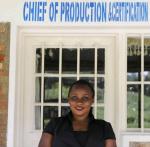
9 tips to go green in the coffee sector
Growing, preparing and selling coffee can harm the environment. Coffee consumers are becoming worried about the industry’s sustainability, particularly in Europe. Europe consumes about one-third of all coffee produced worldwide. This means there is a growing demand for more sustainable practices in the coffee sector. It is important to be aware of environmental issues and how to tackle them to be competitive on the European market.
Contents of this page
- Address environmental issues by tackeling the main causes
- Reduce the ecological footprint of your coffee
- Reduce the carbon footprint of your coffee
- Look into getting certification
- Be aware of European Union Regulations
- Know the cost of going green and take steps to mitigate risks
- Take advantage of your sustainability efforts
- Adopt a circular economy model
- Find funding, partners and investors to support your journey to go green
1. Address environmental issues by tackeling the main causes
If you work in coffee production, you should know what causes sustainability problems. You can use sustainable practices that protect the environment and keep producing coffee by working with farmers and other organisations.
Enhance farmers’ living incomes by paying fair prices
Everyone deserves to earn enough to live a good life. However, many coffee farmers do not make enough money to support themselves and their families. This affects their wellbeing but it can also harm the environment. If farmers do not earn enough, they may cut down forests to expand their farms. They may also use harmful chemical fertilisers or pesticides because they cannot afford safe ones. Climate change is also a challenge for farmers. Farmers often cannot afford to adapt to changing weather patterns and reduce their environmental impact.
Read Tips to become a socially responsible exporter in the coffee sector to learn more about how to support ethical and socially responsible coffee farming practices.
Partner with and support farmers in their environmental sustainability efforts
Exporters or cooperatives usually ask coffee farmers to change their farming practices. They often recommend using more sustainable farming methods or getting certificates. However, many farmers may not understand why these changes are necessary. They may also not have the resources or knowledge to put them in place.
It is important that you work with the coffee farmers as partners. This way, you can make effective and sustainable changes.
You can help farmers achieve environmental sustainability in lots of ways. This can include:
Supplying education and training: Cooperatives can provide workshops and training programmes. These can help farmers learn about sustainable farming practices. Workshops and programmes can focus on agroforestry, composting and integrated pest management. Learning helps farmers improve their yields while minimising their impact on the environment.
Offering technical help: Cooperatives can also provide farmers with technical help. This can include soil testing, crop monitoring and pest control advice. Technical help helps farmers identify areas where they can improve and make changes to benefit the environment.
Supplying access to resources: Cooperatives can help farmers access the resources they need to implement sustainable practices. This could be organic fertilisers and natural pesticides. This helps farmers reduce their use of harmful chemicals. It also promotes more sustainable farming practices.
Work with other partners
Cooperatives alone cannot address farmer poverty and build more environmentally sustainable farming communities. The challenges that coffee farmers face require a collaborative approach involving lots of stakeholders. This means that you have to work with other actors. For example, other cooperatives, non-governmental organisations (NGOs), local platforms, governments and service providers.
NGOs have knowledge and resources that can complement your efforts. Partner with NGOs who can supply training and technical help to coffee farmers. NGOs can help farms increase their yields and improve their agricultural practices.
Local platforms are also very important partners. There are platforms that bring together different actors. These actors can be farmers, government officials and service providers. They do this to find and address local communities’ specific needs. You should take part in these platforms to learn about coffee farmers’ needs and to work with them to address these needs.
Government agencies are also important in supporting farmers. Governments can provide cooperatives and other stakeholders with funding and resources. They can do this to support education, training, infrastructure development and credit access. You should partner with government agencies and other cooperatives. This way, you can encourage policies that support sustainable farming practices. This can include lobbying for subsidies for sustainable agriculture, promoting regulations that reduce harmful chemical use, supporting conservation efforts and more.
Service providers can also help to address farmer poverty. You can work with these providers to ensure coffee farmers have access to high-quality inputs and affordable credit. These are vital to the success of coffee production.
Tips:
- Combine your environmental efforts with your efforts to be a socially responsible exporter. See Tips to become a socially responsible exporter in the coffee sector for more details.
- Work with civil society organisations, companies, service providers and governments. This way, you can get to the root issues of environmental degradation in the sector.
- Integrate sustainability into fundamental business decision-making processes.
2. Reduce the ecological footprint of your coffee
Practices in the coffee value chain can harm the environment. They can use up resources like water and land. It is important to know about the ecological impact of coffee production. You need to know about this so you can work towards sustainable farming practices. Understanding the ecological impact of your actions will help you follow rules. This means you can ensure your operations do not harm the environment. One useful way to understand your impact is to measure your ecological footprint. ‘Ecological footprint’ refers to how much land and water you need to produce coffee and to absorb the generated waste.
Figure 1: Ecological footprint
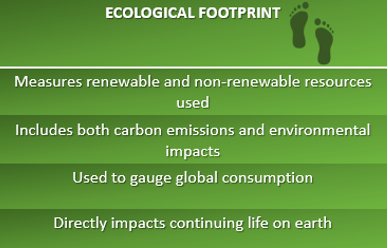
Source: 8BillionTrees.com
The ecological impact of coffee farming can vary depending on the methods used. Coffee farming practices can have high ecological footprints. This means they have a significant negative impact on the environment. Chemical pesticide and fertiliser use also contribute to the ecological footprint. Another factor is using fossil fuels for farm machinery and processing activities. Poor waste and water management can also affect the environment. These practices can damage the soil, kill animals and plants and pollute water. This makes the ecological footprint bigger.
Table 1: Practices with high ecological footprint
| Practice | Ecological Footprint |
| Full Sun, Monoculture Production | High |
| Chemical Use | High |
| Fossil Fuel Use | High |
| Poor Waste Management | High |
| Poor Water Management | High |
Farmers can adopt different practices to make coffee farming’s ecological footprint smaller. They can practice agroforestry, use organic fertilisers and recycle coffee leftovers as fertiliser. On the cooperative level, you can implement efficient water and waste management practices. These can help you reduce your environmental impact.
Tips:
- Watch this video about the ecological footprint to better understand our human demand on nature.
- Use this calculator to measure your ecological footprint. This example is not directly related to coffee production. However, it can help you understand how you personally contribute to your ecological footprint. It will also encourage you to take action concerning your coffee production, sourcing and processing.
Promote agroforestry practices and reduce deforestation
The demand for coffee worldwide continues to grow. As a result, farmers are clearing ever more land for coffee farming. This means that more forested areas could be turned into coffee fields. This risks harming delicate ecosystems that contain unique creatures and plants. It also harms important natural processes, like supplying clean water and preventing flooding. This harms the climate. We may need 10–20 million extra hectares of land (estimated by FAOSTAT) for coffee production in the future, on top of the 10 million hectares used currently.
Farmers sometimes cut down trees to grow coffee without any shade trees. This process is called ‘full sun monoculture’. The yield of full-sun coffee farms decreases very quickly after it reaches its peak. This is because of the loss of biodiversity, frequent use of chemicals and rapid loss of soil health to support coffee production. When the yield decreases, farmers cut down more trees to expand their farms.
Figure 2: Cycle of deforestation
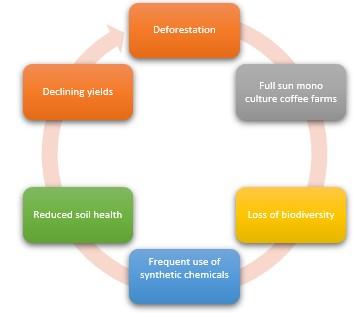
Source: Amonarmah Consults
Farmers and some cooperatives also dry coffee in the sun on raised wooden beds (see Figure 3). Wooden beds need wood from trees. They are exposed to the weather too, so they need to be replaced at least every year, further contributing to deforestation.
Figure 3: Raised wooden beds for sun-drying coffee
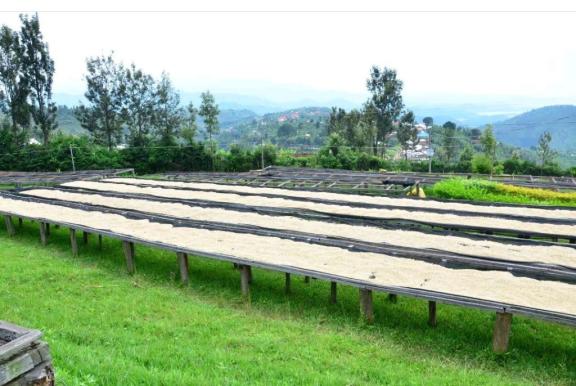
Photo provided by Grace Izerwe (Kopakama cooperative Rwanda)
Cooperatives can also start using concrete beds and metallic beds (see Figure 5) to sun-dry coffee. You can help farmers to get these. They are more expensive in the short term. However, they help reduce the number of trees that get cut down, so they have ecological benefits. You will also not need to spend money cutting down trees or building these beds every year. This saves money in the long term.
Agroforestry is the practice of mixing forest and timber trees and coffee plants in the same area. It can contribute to breaking the cycle of deforestation (see Figure 4). The trees provide a habitat for birds and other wildlife. This helps to preserve biodiversity. Agroforestry systems also positively affect the natural control of coffee pests. Agroforestry helps to preserve forests. This means farmers can receive extra income from the sale of timber and other forest products.
Figure 4: Agroforestry coffee system
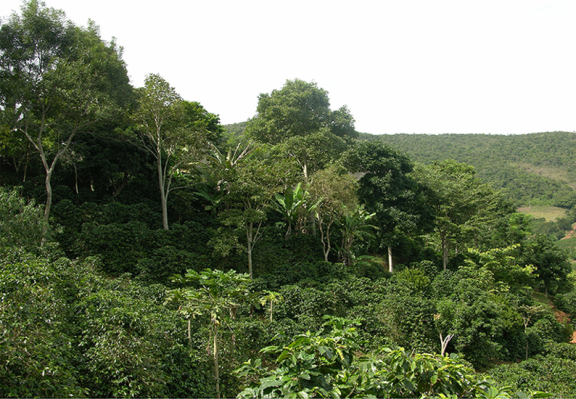
Source: Venzon, M. (2021)
Planting trees in a coffee farm also provides watershed protection. Growing coffee with the full-sun method leads to more beans. However, it is cheaper and better for small farms to grow coffee in the shade. Trees are valuable in the long term. It also costs less to grow coffee in shaded areas. And coffee from these areas can sell for higher prices too. Saving forests and growing coffee with trees can help farms make money and take care of the land at the same time.
As a cooperative, you can train your farmers in agroforestry practices. As an exporter, you can work with cooperatives. You can set up nurseries of trees species to supply to farmers to plant on their coffee farms. You could consider employing or partnering with an experienced agronomist to manage a nursery. For example, the Sustainable Harvest Coffee company partners with cooperatives and agronomists. Together, they help farmers to grow trees. They raise free seedlings of timber tree and forest species for coffee farmers in Rwanda. One social benefit is that they create employment for plant nursery workers.
Another good example is the Masaka Co-operative Union Ltd. in Uganda. It has planted a model forest with over 12,000 hybrid Eucalyptus clones. These clones are drought-resistant, fast-growing and pest-resistant. Cooperatives can also partner with agronomists and forestry departments in their country to set up forests by planting trees in deforested areas in the community.
Figure 5: Raised metallic beds for sun-drying coffee
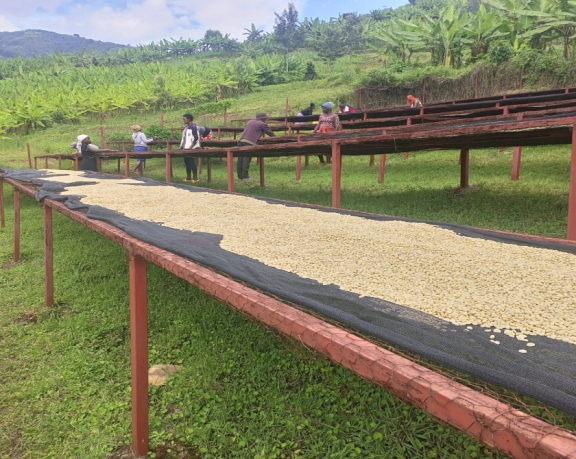
Photo provided by Grace Izerwe (Kopakama cooperative Rwanda)
Tips:
- Learn more about planting trees in a coffee farm, the types of trees to avoid and the characteristics of trees you can interplant with coffee.
- Farmers face climate change problems due to deforestation. Sustainable practices can include climate adaptation strategies. Learn more about adaptation strategies for farmers, plantations and producers.
Train and support farmers on soil conservation techniques
Coffee farming can lead to soil erosion. This happens because of deforestation. Most coffee farms are on hillsides or slopes. When heavy rain falls, the water runs down the slope, washing the topsoil away.
If a farm only has coffee trees, they all use the same nutrients in the soil. The trees do not replace the nutrients. This leads to soil exhaustion. As a result, the living organisms that can help the soil stay healthy die. The soil then becomes more vulnerable to erosion.
Soil conservation techniques help to reduce soil erosion. They improve soil health and protect soil fauna and flora. They can also help to prevent soil and mud building up in rivers and water bodies. It is important that you train and support your farmers in these techniques.
Building terraces involves making level platforms on sloped terrain. Terraces help to slow down the flow of water and prevent soil erosion. This requires a lot of labour and may be expensive. Another approach to support farmers in reducing erosion is to plant cover crops. You can use plants like legumes and grasses. You can plant them between coffee plants to help protect the soil. Cover crops improve soil quality and provide extra nutrients.
Cover crops can also be companion crops. For example, you can teach farmers about companion planting. This involves growing different crops together so they can help each other. Planting beans next to coffee plants can help replace nitrogen in the soil. This benefits the coffee plants. Cooperatives can provide training on how to select the right companion plants, how to design companion planting systems and how to manage systems so they have the most benefits.
Encourage sustainable farming practices
Coffee farmers may feel like they have to choose between making a lot of coffee to sell quickly and taking care of the environment. They may use chemicals that are bad for the earth so they can grow more coffee faster.
It is important to train and support farmers in adopting sustainable practices. This will help them reduce the amount of chemicals they use. This will reduce costs and improve the environment and their health. It also reduces the risks of having high residue levels in coffee beans. This makes the coffee better for consumers.
Intercropping: You can intercrop coffee farms with fruit trees. Cooperatives can teach coffee farmers about intercropping. Practical training and educational sessions are best for this. Cooperatives can organise workshops and on-farm demonstrations. They can show farmers the benefits of intercropping, such as better soil conservation and pest control and higher yields. Training programmes can also cover selecting crops, planting techniques, maintenance practices and more. Cooperatives can provide access to technical resources and experts. They can also encourage farmer-to-farmer knowledge.
Applying and disposing of chemicals in a sustainable way: Cooperatives can train farmers on how to use chemicals sustainably. They can provide workshops and on-farm demonstrations. These can focus on showing farmers how to use chemicals safely and dispose of them in an environmentally responsible manner. They can also focus on other topics, like choosing the right chemicals, proper dosage and application timing.
Using alternative methods for pest control: You can show farmers how to identify natural predators and how they can be used to control pests in a sustainable way. This can involve introducing beneficial insects or providing nesting habitats for birds that eat harmful insects but do not destroy the coffee.
Developing a farm management calendar: Cooperatives can create a farm management calendar. This can assist coffee farmers in managing their crops in a more sustainable and effective way. The calendar can show the best times to complete activities like planting, pruning, fertilising and pest control. This helps coffee farmers plan their work better. This means they can use their resources more efficiently and increase productivity.
You can work with agricultural experts to find the best timing for different farm activities. For example, you can work with agronomists and agricultural extension workers. You can share this information with farmers in workshops and training programmes. You should update the calendar regularly to account for changes in weather, market conditions and other factors that could affect coffee production.
Reduce water waste and pollution
Coffee farming and processing need lots of water. This can be a problem in areas where water is scarce. Wet coffee processing also needs large amounts of water. The water used for fermentation can become highly acidic and contain significant amounts of organic matter.
For smallholders, the easiest way to dispose of this water is often by leaving it to leak into the soil. This can pollute surface and ground waters and in turn harm animals in the water and other animals and humans who drink it.
Treating wastewater from coffee processing before discharge is essential to prevent water supplies downstream becoming contaminated.
Tips:
- Install efficient irrigation systems, such as drip irrigation for coffee nurseries. This will help reduce water use and ensure that water reaches the roots of the plants directly.
- Construct rainwater harvesting systems to capture rainwater. You could use rooftop catchment systems or water storage tanks. This water can be used for irrigation during the dry season and at coffee washing centres.
- Reduce water waste and pollution by installing bio-digesters. A bio-digester is a system that uses microorganisms to break down organic waste into methane gas and organic fertiliser. This gas is a good source of renewable energy. You can use it for cooking, heating or generating electricity.
The Kopakama Cooperative in Rwanda has installed bio-digesters at their coffee-washing stations. The bio-digester technology helps them to minimise water usage as well as effectively recycle wastewater.
Figure 6: Bio-digester system of Kopakama cooperative in Rwanda
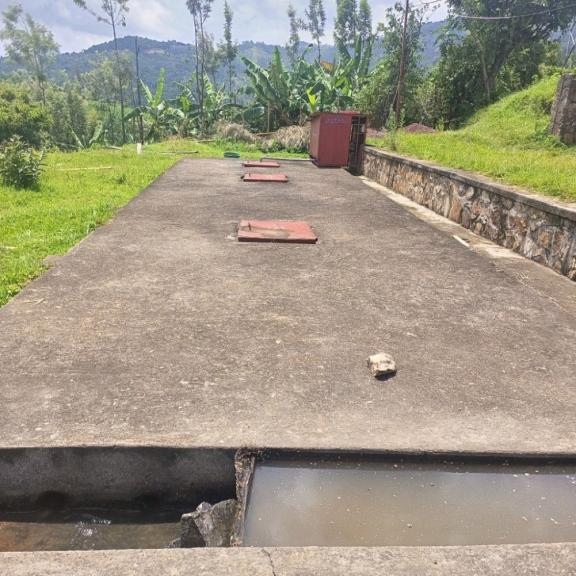
Photo provided by Grace Izerwe (Kopakama cooperative Rwanda)
The construction of a biodigester can vary depending on the size and complexity of your processing system. The available resources and materials are important too. Construction usually involves digging a pit for the tank, and then building the tank walls and roof using the chosen materials. The tank should allow for the efficient mixing of organic waste, water and microorganisms. The pipes that collect the methane gas are usually connected to a burner or stove as a source of fuel.
Tips:
- Regularly monitor your water use. Identify where you can save water, such as by fixing leaks or reducing runoff.
- Read more about a success story from installing a simple bio-digester.
3. Reduce the carbon footprint of your coffee
A carbon footprint measures how much greenhouse gas is produced. Greenhouse gas is measured in metric tonnes of carbon dioxide equivalent (CO2e). Studies show that when we produce one kilogram of unroasted coffee beans in a conventional way we release about 15 kg CO₂-equivalent.
Figure 7: Carbon footprint
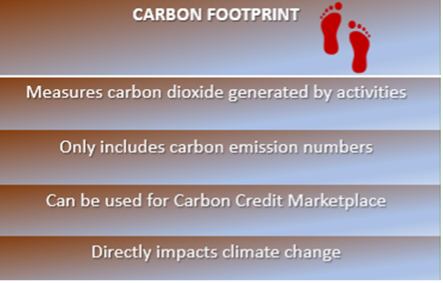
Source: 8BillionTrees.com
Reduce air pollution and greenhouse gas emissions
Transportation has the highest impact on the carbon footprint of coffee. Second is conventionally grown coffee. When farmers grow coffee conventionally, the biggest cause of carbon emissions is fertiliser. In the milling process, fossil fuel use and electricity cause the most carbon emissions (See Table 2).
Table 2: Carbon Footprint in Coffee Supply Chain
| Phase | Impact on carbon footprint | Largest source of the impact | Percentage contribution to total carbon footprint | |||
| Conventional | Sustainable | Conventional | Sustainable | Conventional | Sustainable | |
| Growing | Medium | Low | Use of fertilisers | Fossil fuel use Electricity use | 6 – 7 | 1 – 2 |
| Milling | Low | Low | Fossil fuel use Electricity use | Fossil fuel use
| 1 | 2 – 3 |
| Transportation | Highest | Medium | Exporting coffee by flight | Exporting coffee Cargo ship | 72 – 73 | 6 – 11 |
Source: Nab and Maslin, 2020
The carbon footprint can be drastically reduced using a few key measures. These include:
- Using ships instead of freight flights whenever possible; and
- Replacing chemical fertilisers with organic waste and practising organic farming.
For internal transportation, cooperatives and exporters can reduce their carbon emissions by using fuel-efficient vehicles. When you can, get coffee from local farmers to cut down on transportation.
In organic coffee farming, farmers do not use synthetic pesticides or fertilisers to grow their coffee. They only use organic methods, and sometimes organic pesticides and fertilisers. The carbon footprint of coffee can be reduced by 77% when these measures are taken.
4. Look into getting certification
Importers, roasters and sellers often require certificates to prove their commitment to sustainability. This makes it harder for suppliers without certification to sell in Europe. To get certified, farmers may have to use sustainable methods, like agroforestry and water conservation. Certification helps farmers get market access and higher coffee prices. It is also great for environmental and social sustainability.
Learn about voluntary sustainability standards (VSSs) for coffee production. The main VSSs in the coffee industry are 4C, Fairtrade, organic, Rainforest Alliance and private sector standards, like Starbucks C.A.F.E. Practices and Nespresso’s AAA Guidelines.
While VSSs offer benefits, such as improved market access and environmental stewardship, they also have drawbacks. Certification costs can be high, and some VSSs require complex auditing processes. Some certifications also have a limited impact on farm income and market access.
Overall, the choice of VSS will depend on your specific needs and goals. It is important that you teach farmers about certification and why it is important for them. Be transparent with farmers to help them understand and meet standards.
Table 3: Summary of main Voluntary Sustainability Standards (VSSs) in coffee farming
| VSSs | Explanation | Required Changes | Benefits | Drawbacks |
| Fairtrade | Guarantees fair prices for coffee farmers | Improved labour and environmental practices | Stable and fair prices, community development and access to credit | High certification costs, limited market access |
| Rainforest Alliance/UTZ alliance | Promotes sustainable coffee farming | Environmental and social improvements | Improved market access and environmental stewardship | High certification costs, complex auditing process Limited impact on farm income |
| Organic | Guarantees organic farming practices | No synthetic chemicals or GMOs, improved environmental practices | Better environmental conditions and health for farmers | Lower yields, high certification costs, limited market access |
| 4C | Promotes sustainable coffee farming | Improved environmental and social practices | Improved market access and environmental stewardship | Limited impact on farm income |
| Starbucks C.A.F.E. Practices | Starbucks’ own set of sustainability standards focused on social, economic, and environmental aspects of coffee production | Compliance with sustainable farming practices and environmental protection | Access to premium markets, capacity building and financial support | High certification costs and complex auditing processes |
| Nespresso’s AAA Guidelines | Nespresso’s sustainability programme aimed at ensuring the quality and sustainability of their coffee supply chain | Compliance with sustainable farming practices and environmental protection | Improved market access and pricing, capacity building and financial support | Limited impact on farm income or market access outside of Nespresso |
Here are some practical steps that you can take to get certification:
- Research and decide which certification(s) fit your cooperative and target market best;
- Develop a plan for meeting certification requirements. This can include making changes in farming practices and worker policies;
- Identify the certification body or bodies that offer the chosen certification(s). Contact them for more information and guidance;
- Prepare for and undergo the certification process. This typically involves audits and inspections of farms, processing facilities and administrative procedures;
- Make the improvements or changes based on the audit results to maintain or improve certification status;
- Once certified, promote the certification to potential buyers. Use it as a marketing tool to differentiate your coffee in the market.
It is important that you approach the certification process with a long-term perspective. It may take time and resources to achieve certification.
Tips:
- Learn more about certification and the European market potential of certified coffee.
- Read more about different certification schemes using the International Trade Centre Standards Map.
- Combine audits and seek group certification to save time and money if you have more than 1 certification.
- To convert to organic farming, look for support programmes or initiatives from organisations such as the organic movement in your country or IFOAM Organics.
5. Be aware of European Union Regulations
As a coffee exporter looking at the European market, it is important to know about the sustainability regulations and laws of the European Union (EU).
EU Deforestation Free Regulation (EUDR)
You must meet the EU regulations on deforestation-free products. This aims to reduce the number of forests being cut down and the degradation of forests around the world.
This regulation will come into force in mid-2023. Companies will have 18 months to meet the new rules. This means they have to comply by December 2024. This regulation prohibits the sale of coffee produced on deforested or degraded land after December 31, 2020. There will also be a benchmarking system that assigns risks to countries and regions.
To measure deforested or degraded land, the regulation uses a set of criteria based on scientific evidence. This includes satellite imagery and forest monitoring systems. It aims to identify high-risk areas where deforestation or forest degradation is occurring.
The regulation means cooperatives have to provide information on the origin of their products. This include the specific location where they were produced. The aim is to ensure that they do not come from high-risk areas. Companies themselves are responsible for making sure there is no deforestation or forest degradation in their supply chain.
As a cooperative, you must ensure that your coffee is not produced on deforested or degraded land. Your organisation can use sustainability certification schemes to make sure you follow the EUDR. This may involve using certification schemes with strict environmental criteria that promote sustainable farming practices, such as the Rainforest Alliance certification.
You may also need to provide documentation to demonstrate that your coffee has been produced in compliance with the EU’s environmental requirements. This may include evidence that the coffee has been certified by a recognised certification scheme. Cooperatives can work with certification bodies to ensure they have the necessary documents and meet the requirements for certification. Work with companies like Sateligence and Farmforce. They can help you with tracking deforestation with remote sensing or farm plotting so you have evidence that no deforestation took place in the production of your coffee.
European Union Green Deal
The EU Green Deal is a comprehensive plan to make the EU’s economy more sustainable and reduce greenhouse gas emissions. The plan includes a range of policies and measures related to agriculture, food production and trade.
One of the key goals of the EU Green Deal is to achieve a climate-neutral economy by 2050. This means reducing greenhouse gas emissions to net-zero. To achieve this, the EU has set a target to reduce greenhouse gas emissions by at least 55% by 2030 compared to 1990 levels.
Corporate Sustainability Due Diligence Directive
The Corporate Sustainability Due Diligence Directive (CSDDD) requires companies to identify and get rid of negative human rights and environmental impacts in their operations and their value chains. It is obligatory for large EU companies.
The CSDDD applies to all companies that sell products or services in the European Union, regardless of where they are based. This means exporters from outside Europe who sells goods or services to EU countries have to follow the CSDDD.
Following the regulation may increase costs for exporters who need to invest in systems and processes to carry out due diligence on their supply chains. It also presents an opportunity to stand out from competitors and leads to improved reputation, access to new markets and reduced legal and reputational risks in the long term.
Start by mapping your supply chain to find high-risk areas where human rights abuses, environmental harm or other illegal activities could occur. Next, set up policies and procedures to prevent and address any of these risks.
Communicate with your suppliers and ask them to provide information about their own supply chain and compliance with the CSDDD. You can also train and support your suppliers to help them improve their practices and ensure compliance with the CSDDD.
Tips:
- Learn more about EU regulation on deforestation-free products.
- Read how the EU green deal impacts your business.
- Learn more about the European Due Diligence Act.
- Learn more about the EU rules on Nutrients – action plan for better management. They aim to enhance nutrient management to reduce nutrient pollution and protect water resources. Ensure that farming practices align with the nutrient management guidelines and regulations to prevent water pollution.
- Learn more about EU rules on Pesticides – sustainable use (updated EU rules). These rules aim to promote sustainable use of pesticides and reduce their impact on human health and the environment.
6. Know the cost of going green and take steps to mitigate risks
There are many benefits to adopting environmentally friendly practices. However, there are also risks you need to consider. Financial risks can result in increased costs and reduced profitability. Reputational risks can result in losing customers and reduced sales. Supply chain risks can affect the reliability of your supply chain and cause disruptions to business operations.
Higher costs and financial risk
Environmentally friendly changes mean you need to invest in new technology, equipment and processes. Some of these can be costly, like buying solar panels, biodigesters and electronic vehicles. It can also involve certification costs and training for farmers. This can be a big financial burden, particularly if you have limited resources. Getting certification can also be time-consuming and auditing can be very expensive too.
Even if you get certified, this does not necessarily mean you can sell your product at higher prices or access new markets. For example, even though 55% of total coffee production was certified in 2019, only 25% of this was purchased by the industry worldwide. This means many producers cannot sell their certified coffee at premium prices and face financial risk.
Coffee cooperatives can deal with the higher costs and the financial risks involved in going green in several ways. First, you can look for funding opportunities from governments, NGOs or impact investors that support sustainable practices in agriculture. This can help offset some of the upfront costs of implementing environmentally friendly technologies or switching to organic farming practices.
Second, explore opportunities to sell products at premium prices in markets that value sustainable and ethical production. You will need to generate more revenue and offset the higher costs associated with going green. See Tip 7 on taking advantage of your sustainability efforts.
Third, coffee cooperatives can consider collaborating with other producers to share the costs and risks of going green. This can involve joint investments in infrastructure or pooling resources to achieve economies of scale.
Lastly, take a phased approach to implementing sustainable practices. This can help manage financial risks by allowing for the gradual adoption of new technologies or practices.
Reputational risk
Your partners, suppliers and farmers can affect your efforts towards becoming more environmentally sustainable. They may not be as far along in the journey as you. They may be unaware of the environmental impact of their actions. This can affect your reputation with buyers.
Transparency is key. Communicate sustainability practices clearly to customers and stakeholders. Share information on environmental and social impact and efforts to reduce them. Build trust-based relationships by consistently delivering on sustainability commitments, setting yourself apart from less dedicated competitors.
Create a code of conduct that incorporates green principles into supplier requirements. This code sets up rules with suppliers, ensuring responsible and sustainable production. Environmental requirements may include following sustainability standards, avoiding deforestation and biodiversity loss, following environmental laws, respecting land rights and minimising water and greenhouse gas usage.
Monitor and improve sustainability practices. This will help to mitigate reputational risks and show long-term commitment. Educate farmers, employees and stakeholders about the importance and benefits of sustainability, empowering them to contribute to the coffee sector’s sustainability.
Lower yields
Some environmentally friendly practices, such as organic farming, may result in lower yields. This can affect farm profits if premium prices are not high enough to offset the high labour cost and low yields.
Cooperatives must support farmers in finding new ways to increase yields without compromising environmental sustainability. This can include incorporating beneficial plants that attracts pollinators and natural predators of pests.
Supply chain disruptions
When you start using sustainable practices, you may have to work with new suppliers or change your processes. This can increase the risk of disruptions in your supply chain. Train your employees and follow eco-friendly guidelines for suppliers. Get your input from different places and suppliers to reduce risks if 1 of your sources has problems.
Build good relationships with your suppliers to make sure they do things in a sustainable and responsible way. See the supplier code of conduct above. Tell everyone involved in your business about your sustainability plans. This includes employees, suppliers, customers and regulators. This will help them trust you and understand that you are serious about being environmentally friendly.
Tips:
- Conduct a detailed cost-benefit analysis. This analysis should examine the potential benefits of sustainability initiatives, such as better market share and reputation. You should also look at the potential costs, such as higher upfront investments and lower yields.
- You can help farmers diversify their income sources by taking advantage of the ecosystem created. For example, they can be trained in beekeeping to provide an additional and relatively stable source of on-farm income.
- Work together with industry groups and government organisations. Exchange knowledge on best practices and encourage policies that promote sustainability. This can help others in your supply chain follow regulations.
7. Take advantage of your sustainability efforts
Turning environmental sustainability into a unique selling point can be an effective way to distinguish your coffee products in the market and appeal to environmentally conscious buyers. Here are a few things to do.
Figure 8: Ensure maximum benefits of your sustainability efforts
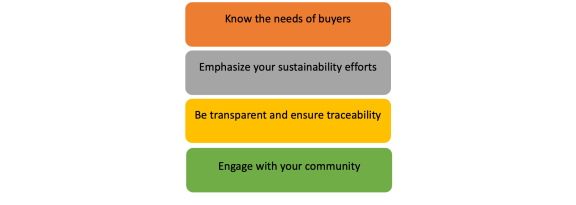
Source: Amonarmah Consults
Know the needs of buyers
Know what your buyers care about when it comes to buying coffee. For example, the EU regulations mentioned earlier tell you about what buyers will prioritise when buying coffee. Incorporate this knowledge into your marketing and messaging. Fit your supply to their needs to appeal to them.
Emphasise your sustainability efforts
Make sure to tell your buyers about your efforts to protect the environment. You can do this by talking to them about your principles and how you produce your coffee sustainably. You can also use social media and a website to share your message. You can also bring your story to life and make short videos to show your efforts. Make it easy for buyers to understand how your coffee is sustainable and helps the environment. You can attend trade fairs and events to show off your sustainability efforts.
An example of this is the Kopakama Cooperative. This cooperative shows its sustainability efforts, telling about all the VSS certifications they have as well as other sustainable farming methods. For example intercropping and how this is helping their farmers. They also attend trade fairs, which helped them to gain new partners and buyers who like their sustainable coffee.
Be transparent and ensure traceability
Be truthful and open about your efforts to help the environment. Share information about how your products are made, where they come from, and other important details. Show how you are being environmentally friendly at every stage of the process. This will show how committed you are to helping the environment.
If you grow coffee using ways that help the environment and use renewable energy, you can sell your coffee using words like ‘organic’, ‘carbon-neutral’ and ‘carbon negative’. That is, after conducting a comprehensive carbon footprint analysis and taking measurable steps to reduce carbon emissions. Note that some companies do not support Carbon Neutral claims. It is important you substantiate your green claims and are truthful with sustainability claims to avoid misleading customers.
Ensure that your sustainability claims are clear, truthful and reliable. To do this, it is important to use easy-to-understand language and supply straightforward information. Avoid using terms like ‘greenest’ if you cannot prove it and describe exactly what makes your product or service sustainable. To prove your sustainability claims, refer to independent research and standards. You should also regularly check that your proof meets current standards, knowledge and technology.
Engage with your community
Get involved in local environmental initiatives and events where you do business. Lead and engage these communities in sustainability activities. You can arrange events like workshops and plastic collection campaigns.
Tip:
- Read The Ultimate Guide to Marketing Your Rainforest Alliance Certified Product to learn how to communicate your sustainability story.
8. Adopt a circular economy model
A circular economy model means making products and processes in a way that creates less waste and encourages recycling and reusing. As an exporter, you could find ways to reuse coffee bean bags. Alternatively, you can partner with organisations and others to recycle them. Another circular economy model is charring, which we describe below.
Charring
There are 3 ways to process organic wastes from coffee production: composting, charring and co-composting. These can be small and large-scale processes. Charring is the most promising method. However, no one has studied it in the coffee sector yet.
Charring involves heating organic material, such as coffee pulp, at high temperatures without oxygen. The process of charring converts the organic material into a more environmentally friendly state. It becomes a molecule made up of carbon atoms that is strong and does not easily break apart. It works as a soil additive. It produces a porous, black substance called ‘biochar’, which is a type of charcoal. Biochar is beneficial for the environment and farm businesses.
For the environment, biochar can help reduce greenhouse gas emissions by locking carbon into the soil for a long time (from hundreds to thousands of years). This can also improve soil quality, conserve water and reduce soil erosion.
For farm businesses, biochar can improve crop yield and quality when used as a soil amendment. It can also help reduce the need for chemical fertilisers and pesticides. This can save money and reduce environmental impacts. Tests have shown that it can increase yields by up to 17%.
Tip:
- Read more about the advantages of biochar in coffee.
9. Find funding, partners and investors to support your journey to go green
Sustainability efforts can be very expensive to install. However, the benefits are central not only to the implementers. They are also central to local communities, the country and the world at large. Having funders, partners and investors can help you to implement many of the sustainable actions for your business. There are many coffee buyers, NGOs and consumers who care about sustainability and will support it.
It is important to take some first steps to attract them. First, find areas in your supply chain that need to be more sustainable. Next, develop a comprehensive sustainability strategy. This should outline your goals and aims for reducing your environmental impact. This strategy should include measurable targets, a plan for implementing sustainable practices and estimated costs.
Start by making changes you can afford. Finally, present your plan to buyers, NGOs and industry networks.
Tips:
- Look for ways to get money for your business that helps the environment.
- Meet and talk to groups that care about the environment and want to help businesses. Go to meetings and events or join online groups. Ask these groups how to meet people who might invest in or work with your business.
- Work with schools and research institutions that study the environment. They might have programmes that can help your business be more environmentally friendly. You can also learn about how to get money for your business.
- Work with groups that want to make the world cleaner and healthier. They can help you to do better things for the environment. They might also have money or other resources to help your business grow.
Molgo Research, Amonarmah Consults and Ethos Agriculture carried out this study on behalf of CBI.
Please review our market information disclaimer.
Search
Enter search terms to find market research

